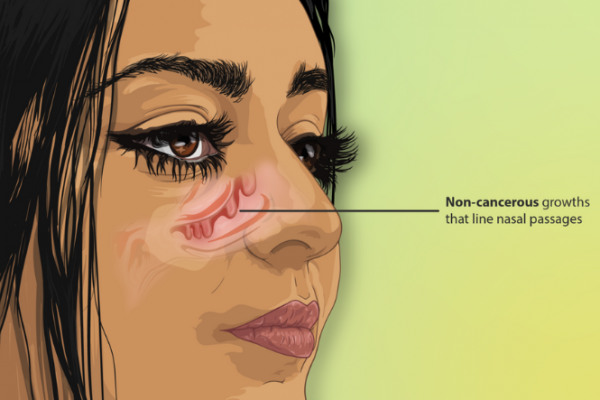Nasal polyps
Key points about nasal polyps
- Nasal polyps are small swellings or bags of fluid and mucus that occur in the linings of your nose or sinus cavity.
- They're usually harmless, but may cause a stuffy runny nose, changes to taste and smell, headaches and snoring.
- You may have 1 nasal polyp or sometimes several grow like a small bunch of grapes on a stem.
- Polyps usually affect both nostrils and can slowly get bigger, blocking your nose.
- They can be treated with steroids (nasal sprays or tablets) or can be removed if they're very large.

Nasal polyps are small swellings or bags of fluid and mucus that occur in the linings of your nose or sinus cavity. They're usually harmless, but may cause:
- a stuffy runny nose
- changes to your taste and smell
- headaches
- snoring.
You may have a single nasal polyp or sometimes several grow like a small bunch of grapes on a stem. Polyps usually affect both nostrils and can slowly get bigger, blocking your nose.

Image credit: myupchar(external link) via Wikimedia Commons
The exact cause of nasal polyps is unknown, but they can come with problems that cause inflammation of the nose, eg, hay fever and rhinosinusitis (inflammation of the nose and sinus). They are also more common in people with asthma, cystic fibrosis and allergy to aspirin.
At first, the symptoms of nasal polyps are like having a cold – a blocked or runny nose. However, colds usually only last 2 to 14 days and the symptoms improve on their own. If you have nasal polyps, the symptoms won't get better without treatment.
Other symptoms of nasal polyps are:
- Blocked nose and difficulty breathing through your nose. You may find you have to breathe through your mouth more often. This is a particular problem at night and can affect your sleep.
- Ongoing runny nose.
- Postnasal drip – this is the feeling of something continually running down the back of your throat. It's due to mucus coming from the back of the nose because of large polyps.
- Changes in your sense of smell and taste.
- A feeling of fullness or pressure in your face.
- Headaches and snoring caused by larger polyps.
- Sinus infection – sometimes polyps block the drainage channel of the sinuses into the nose. This can make infection of your sinuses (sinusitis) more likely.
If they are low down in your nose your healthcare provider may be able to see polyps by looking into your nostrils using an otoscope (the instrument used to look in your ears) or a small instrument called a nasal speculum. Polyps look greyish-white or yellow.
Often treatment with a steroid nasal spray will be tried if nasal polyps are suspected from your symptoms, even if they are too high up to see.
If they don’t improve you may be referred for a CT scan, or to an ear, nose and throat (ENT) surgeon to have a look up your nose with a small camera at the end of a flexible tube called an endoscope.
Medicine
The main treatment option for nasal polyps is the use of corticosteroids (steroid) medicines. These reduce inflammation in your nose and, over time, shrink the polyps.
- For smaller polyps – steroids are given as a nasal spray. Read more about steroid nasal sprays. These may take 1 to 2 weeks to make any obvious difference to your symptoms. You will probably be advised to use them for at least 4 to 6 weeks. As well as steroid nasal sprays, saline rinses may help.
- For larger polyps – steroids may be given orally (by mouth), as tablets, eg, prednisone. These are usually taken as a short course, for about 1 to 2 weeks.
Surgery
An operation may be advised if polyps are large, or if steroid nose drops or tablets haven't worked.
Polypectomy
This involves removing the polyps with a surgical instrument. It can be done through your nostrils, either with local anaesthetic (awake) or under general anaesthetic. The type of anaesthetic might depend on the number and size of the polyps, where they are and how fit you are for an operation.
Endoscopic sinus surgery
This is done with a general anaesthetic. It might be done if:
- there are lots of polyps
- the polyps are very large
- they're seriously blocking your sinuses.
The endoscope allows the surgeon to see into your sinuses with a camera and do the operation in a place that's difficult to reach with normal surgical instruments.
The following links provide further information on nasal polyps. Be aware that websites from other countries may contain information that differs from New Zealand recommendations.
Nasal polyps(external link) The Australasian Society of Clinical Immunology and Allergy, NZ, 2024
Nasal polyps(external link) Patient Info, UK
Nasal polyps(external link) NHS Choices, UK
References
- Fokkens WJ, Lund VJ, Mullol J, et al. European position paper on rhinosinusitis and nasal polyps 2012(external link). Rhinol Suppl. 2012;23:3
- , , , . Surgical versus medical interventions for chronic rhinosinusitis with nasal polyps(external link) Cochrane Database of Systematic Reviews 2014;12
- Ear, nose and oropharynx(external link) New Zealand Formulary
- Rhinosinusitis(external link) Auckland Region HealthPathways, NZ, 2023 (login needed)
Credits: Healthify editorial team. Healthify is brought to you by Health Navigator Charitable Trust.
Reviewed by: Dr Emma Dunning, Clinical Editor and Advisor
Last reviewed:





